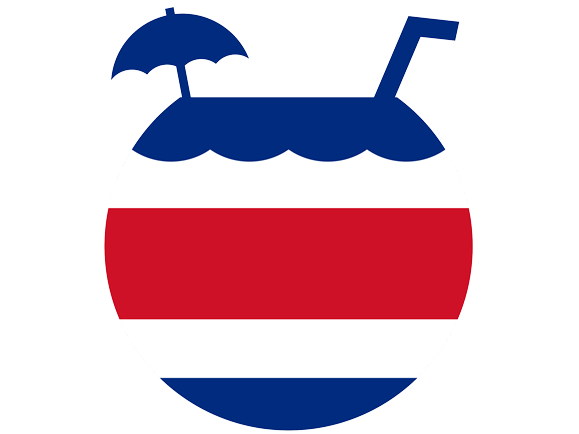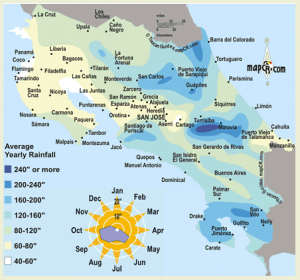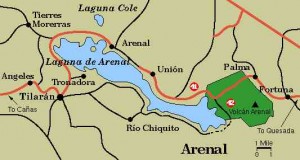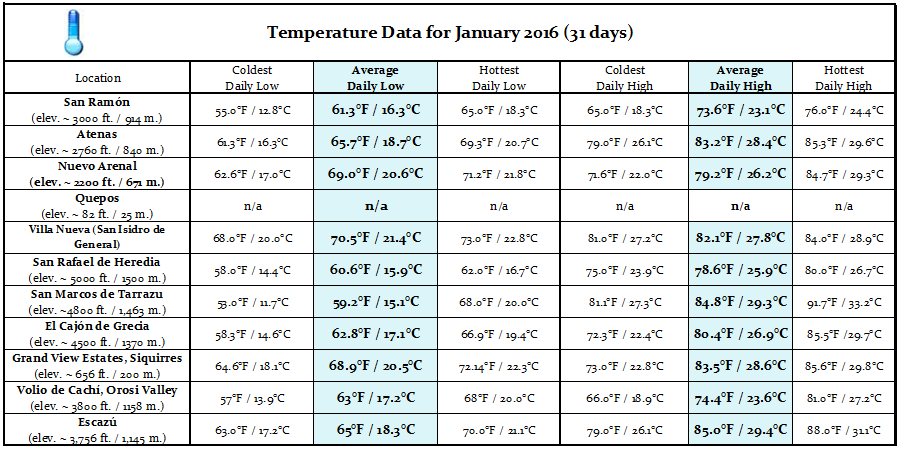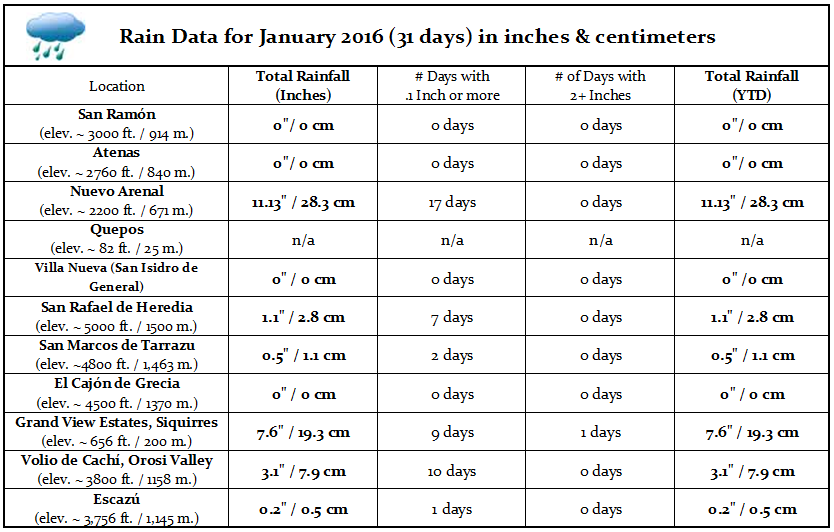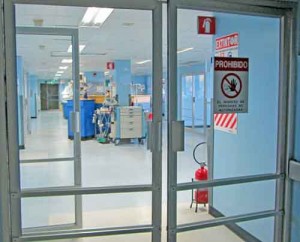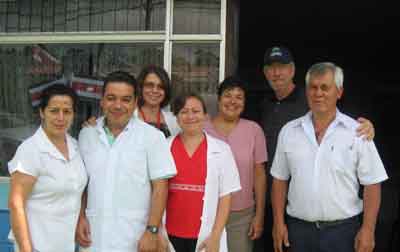Cost of Living, Beauty of CR
Retire for Less in Costa Rica – February 27, 2016
Welcome to our Retire For Less In Costa Rica Newsletter
In This Issue: It’s All About the Weather!
- Costa Rica Winds (Video)
- A Windy Day Bus Ride in Bajo La Paz
- Snapshots of Life in Costa Rica – Wind, Clouds, and Sunsets
- Monthly Costa Rica Weather Report for 11 Towns in Costa Rica–January 2016
- Our Ultimate CR Healthcare Tour
 Costa Rica Winds (Video)
Costa Rica Winds (Video)
Summer in Costa Rica brings many things on the Pacific side of the country — blue skies, day after day of no rain (as opposed to the Caribbean side of the country where it rains year-round), tourists, and snow birds. It also brings the wind. Usually a sign of the change over from the rainy season to the dry season, the windy season is called the “Christmas Winds,” because they usually occur in December and early January. But this year, the winds came later than usual and they are also stronger than usual.
At our home, located at 3,000 feet elevation, and about 10 minutes from downtown San Ramón, The gusts have been up to 70 mph and high temps of the day have been down as low as 62°F. Now, we don’t expect our friends living up north to feel sorry for us. After all, it’s not snow or ice. And it IS still Costa Rica. We’re not complaining, but you have to see it to believe it:
A Windy Day Bus Ride in Bajo La Paz
by Andreas Knox Turner
A Day From My Journal: Wednesday, Feb, 10, 2016
The value of a long-term residency here is that you truly come to realize how magical worlds are created by certain kinds of weather that, to be honest, are really quite hostile to humans. First, we are technically in the dry season as of December, which means we have front-loaded all the rain we need during the torrential months of May through November, but climate change is slowly changing that equation. Here in Bajo La Paz we are now in the sixth day of driving winds between 80 and 110 kph with saturated air breaking out into rain curtains and pellet rain. Night and day. The daily buses creep along the Piedades Norte ridge, unprotected as it is. Yesterday, the bus’s left side wheels lifted off the ground from a spectacular wind gust. The locals, unperturbed, leaned strongly to the left, as if riding their own bike. The dispositioning of the bus caused a metal floor plate to pop out of place. The driver pulled up the emergency brake and stamped the plate back into place. Passengers laughed, as if they had seen this many times before.
On this stretch of the Piedades Norte ridge, there is no shoulder. The road itself is paved, but a 1.5 lane road simply drops off into oblivion. If this stretch were your stop, you would use the other traffic lane for walking home, further up, to your house, which might be accessed by a sharp cut-back road into the side of the ridge. In heavy rain, this might double as a stream. But in any case a vehicle turned on its side by wind, or whatever, would most certainly translate into certain death, to be recorded by someone, much later, maybe two hundred meters below. Still, the bus crowd was a pretty upbeat group.
One could claim that ignorance is bliss. But that is not the case here. Oblivion is beautiful. The world rises and falls in rich greens and swirling clouds with spears of sunlight punching through to highlight a distant village, the crest of a ridge, a river basin. In Spanish, one often hears the tag line used when plans are made, “si Diós quiere.” (Literally, if God wants it to be.) Fatalistic? Maybe. Expecting a kind of invisible luck to keep one safe? A truly personal relationship with their God? I don’t know. What I do know is this. At the end of a scary morning for me, the world around me laughs it off, and the two women I know from Bajo La Paz who were sitting in front of me never missed a beat in their conversation about a shoe sale taking place at a new place that opened across from Supermercados Molina.
Bajo La Paz, San Ramón, Alajuela
República de Costa Rica / Centroamérica
![]()
Monthly Costa Rica Weather Report for 11 Towns in Costa Rica – January 2016
You’ll notice that we now show rainfall and temperatures for eleven towns in Costa Rica:
- San Ramón de Alajuela
- Atenas
- Nuevo Arenal
- Quepos
- Near San Isidro de General
- San Rafael de Heredia
- San Marcos de Tarrazu
- El Cajón de Grecia
- Grand View Estates, Siquirres
- Volio de Cachí, Orosi Valley
- Escazú
This isn’t weather forecasting. We report after the fact to give you a much better picture of the weather in each of these areas. You can click on the map above to enlarge it and check out the average rainfall for the towns in which you are interested.
We’d like to introduce our two newest Weatherguys!
First up,  we’d like to welcome our new Escazú Weatherguy, Tim Garrett.
we’d like to welcome our new Escazú Weatherguy, Tim Garrett.
Tim Garrett was born in Costa Rica, and with an international background, with strong European and Latin American influence. He loves spending time outdoors with whatever activity that comes his way.
He works as General Manager of Garrett Brokers (www.garrettbrokers.com), a family owned insurance broker, that has serviced the expat community for more than 35 years. They handle Automobile, Homeowners, Liability, Medical insurance and more. Garrrett Brokers, where both English and Spanish are spoken, is even a stop on the Retire for Less Ultimate Healthcare Tour.
 And we are also delighted to welcome John Michael Arthur who lives in Volio de Cachí, in the beautiful Orosi Valley.
And we are also delighted to welcome John Michael Arthur who lives in Volio de Cachí, in the beautiful Orosi Valley.
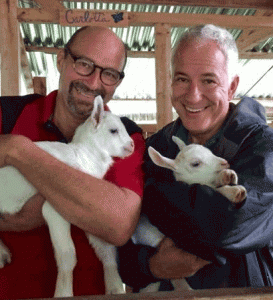 The retirement destination was quickly narrowed down to Costa Rica. After three years and too many recon trips to count, they found a 3 1/2 acre farm complete with a river in the Orosi Valley. They wandered the property in awe for almost an hour before even entering the house. It didn’t matter what the house was like, this was THE place.
The retirement destination was quickly narrowed down to Costa Rica. After three years and too many recon trips to count, they found a 3 1/2 acre farm complete with a river in the Orosi Valley. They wandered the property in awe for almost an hour before even entering the house. It didn’t matter what the house was like, this was THE place.Observations, Facts, & Tidbits for January
Paul’s San Ramón Observations, Facts, & Tidbits for January:
- Five days of the month had the highest high of 76°F, so it was a cooler month overall. Our coldest night of the month, it got down to 55°F at our house, at 3000 ft. elevation and 10 minutes from downtown San Ramon. It will start warming up in February as the sun moves north from the Tropic of Capricorn, arriving at the equator on March 21st.
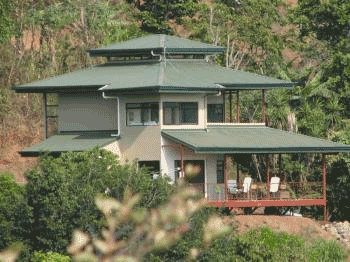 The owners of our incredible rental house were here for 2 weeks in February to prepare the house for sale. If you are interested, please contact us as it’s officially on the market. Once it’s sold, we hope to move into a rental in downtown San Ramon.
The owners of our incredible rental house were here for 2 weeks in February to prepare the house for sale. If you are interested, please contact us as it’s officially on the market. Once it’s sold, we hope to move into a rental in downtown San Ramon.- Gloria and I were invited to the International Living Conference in New Orleans in April. This will be our 11th IL conference. When people come to our table, we tell it like it is, the “good, the bad, and the ugly” about overseas retirement.
- To take advantage of the free (to us) airfare, we plan to stay an extra few days to explore New Orleans and enjoy lots of creole/cajun cooking. Gloria is especially looking forward to introducing me to beignets at Cafe du Monde and muffulettas from the Central Grocery.
- Just to let you know, we walk the walk on about $2000 per month, and have been for the last 7 years.
- We say this all the time, “We can’t believe our lives, this exciting, rich, rewarding, fun life we live. So thank you one and all for reading RFLCR!

- Total rainfall for the last 3 years in our area of San Ramón:
- 2015 – 103 inches
- 2014 – 120 inches
- 2013 – 111 inches
Lance T’s Atenas Observations, Facts, & Tidbits for January:
- The weather in January was almost the same as last year but with marginally cooler (i.e. fraction of a degree) daytime high and overnight low temperature averages.
- Most days were completely clear, some days were partly cloudy, and there was absolutely no rain. However, only a few miles away towards the north/northwest there is ridge separating the Atenas region from the San Ramon region. It runs along at an upper elevation of about 3500 to 4500 feet and was often shrouded in fog at sunrise and for a couple of hours thereafter.
- This is coffee growing territory and is undoubtedly quite cool and chilly in the early mornings.
- Total rainfall for the last 3 years in our area of Atenas:
- 2015 – 63.70 inches
- 2014 – 73.59 inches
- 2013 – 63.84 inches
John’s Nuevo Arenal Observations, Facts, & Tidbits for January:
- We had an average January, weather-wise, and took advantage of it by taking our daily hike through the forest behind our house with our Great Danes.
- Our Great Dane “puppy,” Mancuso, turned one year old on January 30th and we celebrated with lots of hamburgers. We saved the largest burger for Mancuso, put a candle on it, and blew it out for him.
- Total rainfall for the last 3 years in our area of Nuevo Arenal:
- 2015 – 208.34 inches, setting a new record!
- 2014 – 184.95 inches
- 2013 – 164.75 inches
Lance M’s Central Pacific Observations, Facts, & Tidbits for January:
- Lance and his wife were traveling for most of the months of December and January. Lance will resume his weather reports for the month of February.
- 2015 rainfall in our area was 130.3 inches through the end of November.
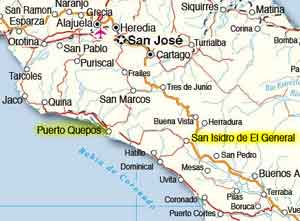 2014 rainfall for the Quepos area of the Central Pacific was 73.54 inches (as of February 2014 when I started measuring it for this newsletter).
2014 rainfall for the Quepos area of the Central Pacific was 73.54 inches (as of February 2014 when I started measuring it for this newsletter).
Gordon’s Villa Nueva (San Isidro de El General) Observations, Facts, & Tidbits for January:
- We had no rain at all for the month….things sure are getting dry! Lot’s of dust when you are off the
pavement – great for the car wash business! - We now have completed furnishing our house. In November we had ordered a loveseat from Ashley Furniture, and that was delivered the first week of January. We had a couple of bar stools made for us, and a week ago we took a road trip to Sarchi and got a couple of nice rocking chairs. Sarchi is a town NW of San Jose that is known for it’s hand crafted furniture, (and it made a great
road trip with a couple of friends!) - We have been looking for gravity chairs ever since we moved to Costa Rica over a year ago, and a recent trip to Price Smart in San Jose (Costco) ended our searching!
- So now we can really stretch out and enjoy this beautiful country! Yup, …… retired life in Costa Rica is pretty darn good!
Steve’s San Rafael de Heredia Observations, Facts, & Tidbits for January:
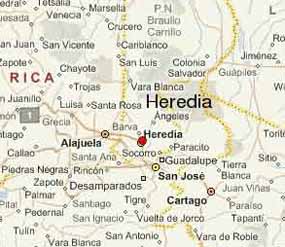 January and the Trade Winds – The Trade Winds and the corresponding rainfall dropped off dramatically this January as compared to last. We had what I’d call nine windy days this January, compared to 18 windy days last January. This January, 1.1 inches of rain; last January, a record-breaking 8.3. Temperatures were about one degree warmer than usual. Looks like we’re in for a severe dry season. For once I’m in agreement with the weatherman. A couple of weeks ago I was talking to the sales person at Zacates Agrícola Leo near the airport in Alajuela and boasting about the rain we got in the dry season and the fact that our grass was green all year except for the month of April. No sooner had I said this than the rains petered out and our grass turned yellow. Oops! Now the water pressure is dropping. We could have a water emergency before we know it.
January and the Trade Winds – The Trade Winds and the corresponding rainfall dropped off dramatically this January as compared to last. We had what I’d call nine windy days this January, compared to 18 windy days last January. This January, 1.1 inches of rain; last January, a record-breaking 8.3. Temperatures were about one degree warmer than usual. Looks like we’re in for a severe dry season. For once I’m in agreement with the weatherman. A couple of weeks ago I was talking to the sales person at Zacates Agrícola Leo near the airport in Alajuela and boasting about the rain we got in the dry season and the fact that our grass was green all year except for the month of April. No sooner had I said this than the rains petered out and our grass turned yellow. Oops! Now the water pressure is dropping. We could have a water emergency before we know it.- Trees – I’m in the process of populating our property with trees. For the first couple of years, I water the trees about three times a month during the dry season. After two years I figure their root systems are extensive and deep enough to handle the drought.
- Water & Power – We use lots of water, almost all of it for the garden and pond. Although we use a lot, we also try to conserve as much as possible. The local utility company charges us only a fraction for water of what we were charged in South Carolina. For electricity, on the other hand, the rate is 60% higher. A year and a half ago we installed solar panels that produce 85% of our power. The price of installing solar electric generating systems has been dropping steadily over the years. In the 1970s I looked into it and went into sticker-shock — the cost of a system would have been more than what we paid for the house. Ten years ago I looked into it again and it would have cost us $25,000. The system we got here cost us about $6,600. My neighbors say this is enormously expensive. From my perspective, it’s enormously cheap. I have seven rainwater storage tanks with total capacity of about 5,000 gallons. Only two months into the dry season and I’ve already used all the water and am beginning to refill the tanks with water from the utility company. I’m doing this in the event the public system goes dry in March or April (maybe even sooner this year). I could easily use another 5,000 gallons of tankage. It rains enough here in a year to fill the tanks many times over. When I first installed the tanks I had a problem with mosquito infestation. I’ve gradually learned how to keep them from breeding in the tanks and can now boast we are 100% mosquito-free. With the Zika virus in the news, it’s comforting to know we have mosquitoes under control.
- Total rainfall for the last 3 years in our area of Heredia:
- 2015 – 144.9
- 2014 – 115.1
- 2013 – 111.3
Bonnie’s San Marcos de Tarrazu Observations, Facts, & Tidbits for January:
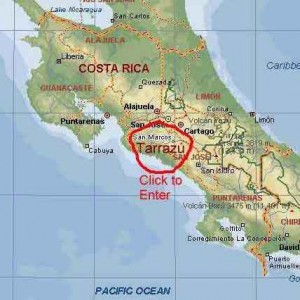 Our temperatures have spanned a wide range as they did in December, but it continues to feel very comfortable here in San Marcos.
Our temperatures have spanned a wide range as they did in December, but it continues to feel very comfortable here in San Marcos.- We’ve had no rain since January 7 and find ourselves missing it.
- The last few days have been very windy, and we don’t think we’re going to miss that!
- 2015 rainfall total is 37.9 inches for the months of August through December.
- We will be moving soon and will continue our weather reporting from our new location in May.
Irina’s El Cajón de Grecia Observations, Facts, & Tidbits for January:
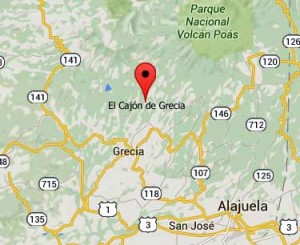 January was full of extremes and record high/low temperatures. The low ones were mostly related to the winds, which picked up strength in January, a month after the typical “December winds.” Seems like the past 3 months shifted to a later date compared to normal.
January was full of extremes and record high/low temperatures. The low ones were mostly related to the winds, which picked up strength in January, a month after the typical “December winds.” Seems like the past 3 months shifted to a later date compared to normal.- November and December showed numbers usually associated with October/November. This continued into 2016 – “typical” December weather occurred in January. The numbers for February are not yet in, of course.
- We measured the lowest night temperature ever since moving here over three years ago: 14.6 °C (58.3°F) on January 24th, which also had the lowest high of 22.4°C (72.3°F) — a very cold day in Costa Rica.
- But on the other hand, we also measured near 30°C (86.0°F) twice — 29.7°C (85.5°F) on the 8th and again 29.3°C (84.7°F) on the 20th — both much hotter than “usual.”
- The winds dried the ground out very much, so we had to start watering, being very careful to adhere to water-saving and conservation methods. Many of our plants are drought-tolerant, but a recent garden re-design of a completed construction site made some watering necessary for the plants to establish. We prefer spot-watering with a bucket when we can clearly see which plant needs watering. It lets us observe each individual plant, making sure it is planted where it’s happy and thriving.
- We’ve included measuring the humidity on our property — amazingly, although it’s the “dry” season, about one third of January measured the overnight humidity in the upper 80’s to 99% range.
- 2015 rainfall for year: 107.6 inches (273.23 cm)
Mike’s Grand View Estates (Siquirres) Observations, Facts, & Tidbits for January:
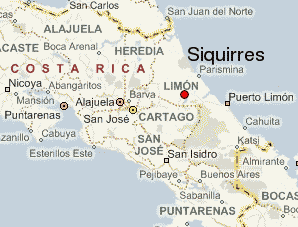 January ended with a day as close to being cloudless as we ever get in the Caribe. Despite the clear skies the temperature never reached 30°C. In fact, we never hit 30°C (86.0°F) all month! One day someone must have left the freezer door open, because we had a chilly high that day of only 22.8°C (83.8°F) (the nighttime low was 20.2°C (68.4°F), so not much variation that day!). That was a real anomaly, and occurred the day following our day with the heaviest rainfall. Excluding that one day, our average daily high was 28.8°C (83.9°F) . The temperature dipped below 20°C 9 (68.0°F) nights during January.
January ended with a day as close to being cloudless as we ever get in the Caribe. Despite the clear skies the temperature never reached 30°C. In fact, we never hit 30°C (86.0°F) all month! One day someone must have left the freezer door open, because we had a chilly high that day of only 22.8°C (83.8°F) (the nighttime low was 20.2°C (68.4°F), so not much variation that day!). That was a real anomaly, and occurred the day following our day with the heaviest rainfall. Excluding that one day, our average daily high was 28.8°C (83.9°F) . The temperature dipped below 20°C 9 (68.0°F) nights during January.- We had no rainfall at all for half the month, plus another 10 days with just a trace of the wet stuff. Total rainfall amounted to 7.6 inches in January, much of which fell on the day mentioned above. This was a far cry from last year, when we recorded 26.5 inches for the month. This was the 5th straight month when we’ve recorded less rain than the previous year. I think that we have returned to a more normal weather pattern after the El Nino disruption. The rainfall map that headlines this newsletter shows that we should expect 80-120 inches of rain (2-3m) annually. If January’s rainfall pattern holds up, we are on track to be in that range over the year.
- On a 12-month moving average basis, we recorded 9m (28.2 ft) of rain between 1 Sept 2014 and 31 Aug 2015!
- Readers might be interested in how we keep in touch with the world. I still run a business in Canada, so Internet and phone are vital. We are too far off the main road for cable and landline telephone service. The developer of Grand View Estates installed a fiber optic system to a central location, then beams a wireless signal to the houses in the development. This gives us 5 mbps Internet at a cost of $100/mo. I use Magic Jack for telephone, with a Canadian phone number so clients can call a local number to reach me here in Costa Rica. We use cellphones for local telephone service.
- For TV, we have subscribed to SKY satellite TV at $32/mo. SKY has a lot of English-language programming. Canadians might be particularly interested to know that we can watch NHL hockey on SKY every night! The first night that we had the system, I watched a Hockey Night in Canada broadcast between the Montreal Canadiens and the Toronto Maple Leafs. As if that isn’t enough, we also subscribe to an Internet-based TV service called USTVNow at $39/mo. This gives us programming out of Harrisburg, PA. We use ROKU as our interface between the house Wi-Fi and our main-screen TV. We subscribe to Netflix, but don’t use it very much. Unfortunately, the agreement between ROKU and Netflix doesn’t cover Costa Rica, so we have to use our laptop as the interface.
- Total rainfall for the last 2 years in our area of Grand View Estates:
- 2015 – 305.7 inches
- 2014 – 208.2 inches (March through December)
Juan Miguel’s Volio de Cachí Observations, Facts, & Tidbits for January:
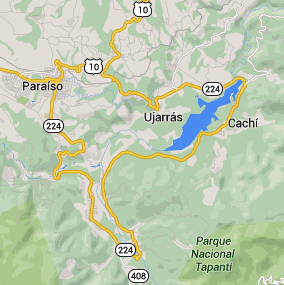 Because we live smack-dab in the middle of CR, our weather is affected by both the Pacific and Caribbean influences. As a result we get some rain even in the dry season.
Because we live smack-dab in the middle of CR, our weather is affected by both the Pacific and Caribbean influences. As a result we get some rain even in the dry season.- We’re at 3800 feet elevation but in a river basin, so our weather is very different from friends’ who live only 2.5 miles away at 5000 feet on top of a ridge.
- This January is much more on par with the usual. Last year, we never really had a dry season and January had rain almost everyday.
- While we had 10 days of measurable rain this month, it mostly occurred overnight or late in the day, leaving us with beautiful days. However, we did had 4 foggy mornings with “pelo de gato” all day (that’s the Tico expression for the fine mist that falls. It means “hair of the cat.”)
- Our average overnight humidity was 80% and the average daytime humidity was 61% Daytime low humidity was 40% and daytime high was 80%.
- Both Volcan Irazú and Volcan Turrialba are loom large here. Turrialba has been much less active this past month.
- While like all across the country, we feel minor earthquakes that originate from farther away, this month we had two quakes with epicenters only about 3-5 Km away. That same 3.7 magnitude feels pretty different when it occurs right next door!
Tim’s Escazú Observations, Facts, & Tidbits for January:
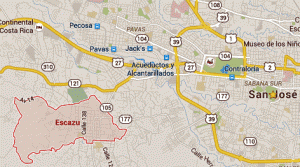 Though we only had one day with measurable rainfall (at least 0.1″), we had a trace of rain on only one additional day.
Though we only had one day with measurable rainfall (at least 0.1″), we had a trace of rain on only one additional day.- Escazú County is one of 20 counties that make up the San Jose Metropolitan Area. It is west of the downtown San Jose area, with the Escazú mountains as its backdrop.
Costa Rica Weather Report for January
Our Weatherguys and Weathergals
Our San Ramón Weatherguy, Paul Yeatman
Meteorology has been Paul’s lifelong hobby. As a child, he devoured books about the weather and earth sciences vigorously. Later, he took a few college courses in meteorology, and still later, he served as a meteorologist for the U.S. Army in Vietnam. Now, Paul gets to practice his avocation in Costa Rica, albeit on a very small scale with just temperature and rainfall data, probably the two most important factors regarding the weather. He wanted to include weather info on our website to help people decide where to live, although weather is just one of many factors to consider in determining where to relocate. Current weather data is from our current home at about 3,000 ft. elevation and 10 minutes outside the town of San Ramón. Weather data prior to December 2012 is from our previous home at about 4,000 ft. elevation and 10 minutes outside the town of San Ramón.

Our Atenas Weatherguy, Lance Turlock
Lance and his wife, Diana, moved to Costa Rica over 4 years ago after living 30+ years in the Lower Mainland of British Columbia (Vancouver and environs). They live in the Central Valley near the town of Atenas and are at an elevation of about 2700 feet. They have no need for air conditioning or heating. Overnight low temperatures are comfortably cool (low 60’s). Daytime highs can be relatively hot (high 80’s, low 90’s), but rarely uncomfortably hot.Lance started to keep track of daily temperatures and rainfall in order to have factual ammunition to help disabuse friends, relatives and acquaintances of any misconception that the weather must be like that of a tropical jungle.
Our Nuevo Arenal Weatherguy, John Nicholas
After many visits to Costa Rica, John and Cathy Nicholas moved from New York to Costa Rica in 1991. They chose Arenal for its sacred, majestic beauty, its lush wildlife, its relaxing lifestyle, and its proximity to activities and sites such as the Volcano Arenal and the beaches. They own the B&B, Chalet Nicholas, which has been in operation since 1992. Temperatures and rainfall are measured at Chalet Nicholas which is located at approximately 2,200 ft. elevation and 1 mile west of the town of Nuevo Arenal.
Our Central Pacific (Quepos) Weatherguy, Lance Miller
 I was born in a very small town in northwest Iowa and raised on a farm. When I was 18, I joined the service, in which I spent 22 years before retiring in 1990. For the next twenty three years my family and I lived in south central Pennsylvania. After having a stroke in 2012, I was unable to work and that is when my wife and I began talking about retiring. Thanks to your newsletter and a website we found about San Isidro, we began looking at Costa Rica. We came down in March 2013 and looked around for a week. Went home, packed up, and moved here in April. We settled in a small village called Playa Matapalo which is located between Quepos and Dominical. We later moved to Quepos. The word Playa means beach. It is so nice to lie in bed and listen to the ocean. Pura Vida.
I was born in a very small town in northwest Iowa and raised on a farm. When I was 18, I joined the service, in which I spent 22 years before retiring in 1990. For the next twenty three years my family and I lived in south central Pennsylvania. After having a stroke in 2012, I was unable to work and that is when my wife and I began talking about retiring. Thanks to your newsletter and a website we found about San Isidro, we began looking at Costa Rica. We came down in March 2013 and looked around for a week. Went home, packed up, and moved here in April. We settled in a small village called Playa Matapalo which is located between Quepos and Dominical. We later moved to Quepos. The word Playa means beach. It is so nice to lie in bed and listen to the ocean. Pura Vida.
 Our Villa Nueva (10 minutes NW of San Isidro de El General) Weatherguy, Gordon Stanley
Our Villa Nueva (10 minutes NW of San Isidro de El General) Weatherguy, Gordon Stanley
Gordon and his wife Bea moved here from Lloydminster, Alberta, Canada, where he used to track the correlation of the winter hoer frost and the spring/summer rains. After 30+ years as a Purchasing Agent for a retail lumber yard/Homes Manufacturing company, he decided to say “Adios” to the snow and ice. They arrived in Costa Rica Oct 2, 2014, and originally lived in Quebradus, which is 15 minutes NE of San Isidro de El General, but as of November 2015 now live in Villa Nueva, which is 10 minutes NW of the city. They are at a altitude of about 800 meters, living in a rental house that friends built on their acreage. The fruit trees are abundant, and in the rainy season the water in the nearby streams can be heard from their deck. They overlook a beautiful valley, and enjoy watching the sun setting behind the hills every night!
 Our San Rafael de Heredia Weatherguy, Steve Johnson
Our San Rafael de Heredia Weatherguy, Steve Johnson
I’m a weather geek and have been recording daily weather data for the last 4 years in Concepcion de San Rafael de Heredia. We live at 5,000 ft. (1,500 meters) elevation, above San Rafael centro on a low ridge that comes off of Cerro Chompipe (between Barva Volcano and los Cerros de Zurqui). We have a 60 mile wide view from Turrialba Volcano east to somewhere around Cerro Turrubares west. I first lived in CR as a Peace Corps volunteer (1968-71), married a tica school teacher, and moved back to Costa Rica in 2009. My wife grew up in downtown San Rafael just three miles away, and the weather is quite different there. I am also an avid gardener and birder.
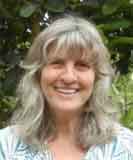 Our San Marcos de Tarrazu Weathergirl, Bonnie Vining
Our San Marcos de Tarrazu Weathergirl, Bonnie Vining
Bonnie, her husband Joe, and their dog Marley moved from Tucson, Arizona, to San Marcos de Tarrazu, in mid-2015. Bonnie was a CPA, turned software engineer with IBM for 20 years and later opened and operated a specialty coffee shop, founded a non-profit dedicated to connecting musicians with appreciative audiences, and managed a school district theatre. A self-professed “data geek”, she looks forward to being our weathergirl while pursuing her other passions which include traveling, gardening, cooking, hiking, meeting people, and hanging out with Joe and Marley. They are enjoying retirement life in the town of San Marcos which lies at about 4,800 ft. in the heart of Costa Rica’s prime coffee-growing region.
Our El Cajón de Grecia Weathergirl, Irina Just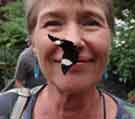
Born in Germany, Irina spent 40+ years in the USA (all on the Pacific coast) before she and her husband Jim moved to Costa Rica three years ago. For the 20 years prior, they owned and operated a vineyard in the Willamette Valley of Oregon, famous for award-winning pinot noir. During that time, it became critical to keep precise records of daily temperatures, rainfall and pertinent weather patterns to accurately forecast seasonal tasks, such as when to prune the grapes, when to harvest, when to protect them from an early or late frost. As little as one degree made the difference between a bountiful harvest – or a lost crop. After moving to el Cajón de Grecia, the Justs continued to take daily readings of temperatures and measurements of rainfall because they quickly discovered that the micro-climate in the foothills of Poás differs widely from the weather in nearby Grecia.
 Our Grand View Estates (Siquirres) Weatherguy, Mike Wise
Our Grand View Estates (Siquirres) Weatherguy, Mike Wise
Carmen and Mike Wise, together with their 2 large dogs, drove to Costa Rica from Calgary, Alberta a little over 3 years ago. Carmen is a professional musician. She was a guest clinician at Suzuki workshops in Costa Rica for many years, so developed good friendships here. Their network of friends helped them ease into the Pura Vida life! They built their own home in the gated community of Grand View Estates. It is located about 9km ESE of Siquirres, at an elevation of 200m. Their home has expansive views out to the Caribbean. Although the climate is tropical rain forest, it never gets too hot. They don’t need air conditioning. They run a small bed and breakfast (see www.amapolaBnB.com). Mike still works as a financial advisor, serving his Canadian clients. Telephone, email and Internet, supplemented by occasional trips back to Calgary, make living and working in a remote location possible. He does his own research and writes a quarterly newsletter Investing Wisely (see www.wiseword.ca).
Related Articles:
- For a “Just the Facts” Version of our 2015 Weather: Costa Rica Weather: 2015 Monthly Temps & Rainfall
- Our Weather in San Ramón & Atenas Costa Rica – 2014
- Our Weather in San Ramón & Atenas Costa Rica – 2013
- Our Weather in San Ramón de Alajuela, Costa Rica – 2012
- Our Weather in San Ramón de Alajuela, Costa Rica – 2011
- 15 Days
- El Nino – What is it?
![]()
Our Ultimate Healthcare Tour of Costa Rica
Our newest tour is the Ultimate Healthcare Tour of Costa Rica. When asked what he liked best about our healthcare tour, one of our guests wrote, “the wide variety of places we saw, the experts that Paul  arranged for us to meet and talk with, and an emphasis on all aspects of health, not just doctors and hospitals. Mental health is just as important as physical, if not more so.”
arranged for us to meet and talk with, and an emphasis on all aspects of health, not just doctors and hospitals. Mental health is just as important as physical, if not more so.”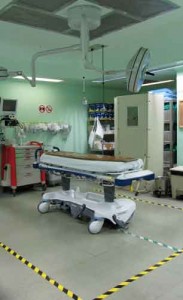
We’ve lived in Costa Rica for over six and a half years and have used the Caja, Costa Rica’s public healthcare system extensively, as well as the private system, when needed. We’ve learned the system and have been referred up the ladder to see specialists in the maze that is the Caja system. Gloria’s even had surgery here.
Our blend of personal insights and on-the-ground experience combines to answer your questions about whether or not Costa Rica’s healthcare system could meet your individual needs.
But, while it is focused on healthcare, you will learn a lot more about living and retiring in Costa Rica’s Central Valley. Most of the second day of the tour takes place in the town of San Ramón where we live and use the services. And you will come to our home for lunch that day to listen to two of our featured speakers.
Our tour is designed to save you both time and money, packing a lot of information into a short period of time. Our goal is to show you the possibilities and to try to demystify Costa Rica’s healthcare system. Our tour lasts two days and 1 night and includes lodging, transportation, meals and non-alcoholic beverages.
Sample Itinerary
You’ll visit:
- At least two private hospitals in San Jose area
- Hospital Mexico, the largest and best public hospital (they even do open heart surgeries there)
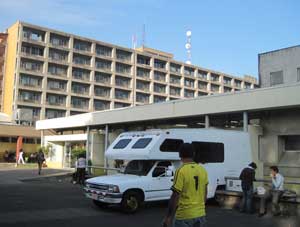
- An insurance broker for a presentation on the various supplemental health insurance options, including public, private, and international plans
- A senior living retirement community
- CPI language school for a presentation about how learning Spanish increases your options for healthcare and some basic medical Spanish.
- Our local hospital here in San Ramón
- A local EBAIS (community clinic)
- A local private medical and dental clinic
- A local Seguro Social office where you would sign up for the Caja (national healthcare coverage)
- A pharmacy
- A health food store (macrobiotica), and more!
You’ll learn:
- If the Costa Rican healthcare system could meet your needs and put your mind to rest, once and for all, about this sensitive subject.
- About the public system and how it works, about the private healthcare system, and how you can use a combination of both to your advantage.
- About the EBAIS – where healthcare starts in Costa Rica.
- Approximately how much you would pay for Caja.
- About medical tourism in Costa Rica.
- About home health care in Costa Rica.
Introductory prices: $550 for a couple, $450 for a single.
Please contact us if you are interested in booking this tour. Space is limited.
Related Articles:
- Paul Gets a CAT Scan Through the Caja
- Integration 102 – Speaking Up at the Hospital
- Waiting to See the Doctor, by Jo Stuart
 Facebook, Twitter, & YouTube
Facebook, Twitter, & YouTube
![]()
![]()
![]() You can now follow us on Facebook and Twitter, so please “like” us on Facebook, “follow” us on Twitter, and watch and share our videos on YouTube.
You can now follow us on Facebook and Twitter, so please “like” us on Facebook, “follow” us on Twitter, and watch and share our videos on YouTube.
 What’s New on the Website
What’s New on the Website
Check out our newest posts on www.retireforlessincostarica.com:
- Our January 2016 Costa Rica Cost of Living Expenses
- Beach Day January 2016
- A Single Woman’s Budget in Costa Rica: How She Lives on $1260 USD
- Where Should You Retire? Here’s a Tool to Help You Decide, by Rob Evans
- Gardening in Costa Rica with Steve – Gardening for Wildlife
- Gardening in Costa Rica with Steve – Q & A
- In the Mailbag: Residency in Costa Rica and Buying a Car
